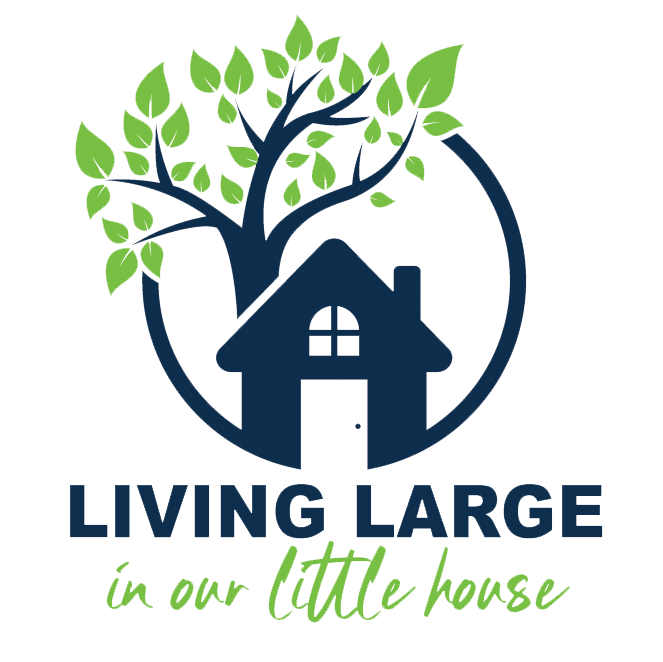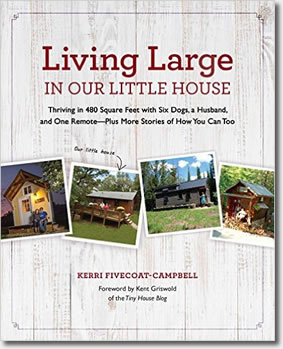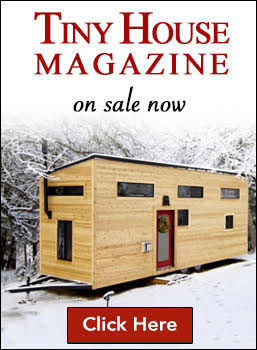Living Green by Living Downtown
Today, I’m happy to present a guest post by Kim Smith, who is part of our Living Large community. Kim lives in an older home, which is another way to live a green lifestyle:
I was honored when Kerri asked me to write about some aspect of “living large” family life in a smaller home. My family lives an hour or so from her, and while we share a common perspective on many things, some of our choices make our life look quite different.
When we moved to small-town Arkansas from big-city Florida, we sought out an old house near the downtown square. At about 1750 square feet, our circa-1916 home is considered by some to be a bit quaint and small to raise a modern family; we think it’s perfect. Many of our reasons for choosing it are “green” in nature:
1) Our home was constructed to make the most of the sun and wind– a necessity before the invention of air conditioning! Our southern windows are large; western and northern windows are small. This helps our energy consumption considerably– especially since we use open windows and fans whenever possible in summer, and use our clothes dryer heat to help heat the house in the winter.
2) Older homes were built before toxic materials like plastics and fiberglass were in use. Now, it was 1960’s ugly when we bought it, inside and out; but we’re getting to restore and renovate as we please, using nontoxic materials wherever possible.
3) A “walkable” neighborhood is a great environmental plus. Our downtown square is a few blocks away; so is the library, the city pool, and the big creekside city park. It’s a great environment for family walks!
4) Our four bedrooms are small, as was custom in the early 1900s… which limits the number of toys and belongings that we can fit into them. Forced simplicity!
5) Most old houses have an old garden spot out back– ours did. We killed some grass, added some organic matter, and started planting. (In the Ozarks, this is a major advantage, as we have more rocks than soil underground and preparing an in-ground garden is a major undertaking.)
6) By “recycling” a pre-existing home, we’re preventing tons of construction materials from being created (from raw materials) for a new building, while also preventing an older home full of old-growth woods and other sturdy materials from heading to the landfill as well.
7) Strangely, older downtown homes are a bargain in our real estate market; newer construction is much more expensive per square foot. Because we chose to live within our means in a smaller, older home, we’re now mortgage-free for the first time in our lives. I can’t begin to tell you how much freedom and peace of mind that gives us– as well as the satisfaction that we’re not sending a cent to the big mortgage companies that helped exacerbate our country’s current crisis.
I cannot deny that I read Kerri’s stories of “living large” and writing out in the woods with a twinge of envy– but we’re all in different seasons of life with different needs. For us, buying an older home in a walkable neighborhood was the perfect choice.
Thank you, Kim, for that post! I read your story and have a twinge of envy as well! I love older homes and if we didn’t live here, we would live in a smaller older home.
Kim has a question for the Living Large community:
Did you choose your current home with the planet in mind? What kind of “green” home do you hope to have in the future?
If you would like to write a guest post on Living Large about your small home, decluttering, preparing for a move or green living, it can be as short as a paragraph. Please send it to me at fivecoat@ozarkmountains.com (no photos until I get back with you!) Also, I will be posting some recipes for making use of our fresh summer bounty. I need more, please send them to me!









Thanks for sharing this. We’re always looking for great resources to send to clients and my colleagues, and this article is certainly worth sharing!
I’m so flattered, Francisco. Thank you!
Great house, great post. Thanks for sharing!
Thanks for stopping by, Emily!
Moving homes about every 3 years growing up taught me to be able to have less and so I could pack things quicker. My Memaw, Mary Ann Nida also taught me to care for what I have so it will last as long as possible. (She’s had the same ironing board for 30 years.) This taught me to conserve and also be what is called green now.
You have a very wise grandma, Missy! 🙂 I’m glad the younger generations have been taught these values so it can continue.
Beyond the main theme, I’d think being “mortgage free” might get the attention of some people.
It grabs my attention, that’s for sure. Our goal within 5 years.
We’ve just moved into a home my darling man’s grandfather built back in 1930. This house was built before electricity or indoor toilets made it to this area of rural New Zealand, so there are some interesting quirks to work around.
We also have a lot of improvements to make, getting insulation up to code, double glazing, modern water heater, etc, but the house is going to be fabulous to live in when we are done.
You’re living a great adventure there in NZ, Frugal! And how wonderful you get to live in a house that has so much history in the country and your husband’s family!
Like Kerri, I love the idea of living in a home with so much family history in it. My family recently sold my grandmother’s place, and I still mourn it (although I wouldn’t have been able to take her place in it). Congrats on carrying on the family legacy in your home!
Kim’s home is adorable!
During our latest renovation, we tried to make as green as possible choices. We live in a really old house, 1700s. Problem is there was no insulation back then, so we had to redo everything, change to energy-efficient windows, etc. Sometimes I think of the people who once lived here and how cold they must have been in winter, without central heating. I imagine them sitting in front of the fire wrapped in raccoon coats. Brrrr!
There’s not getting anymore historic than New England, Alexandra! I imagine it was cold back then, but probably a matter of perspective too. I think the pioneers could take a lot more extremes in the weather than we can today.
What a timely post! My husband and I will close on an earth contact home at the end of this month. We bought land in the country ten years ago and since then, had planned to build a house on it. But- the earth contact house is right across the road from our land and when it came up for sale, we decided it was just too convenient to pass up.
Buying not only saves all the headache and expense of building (our land has never been built on, so all utility lines and water lines would have had to be run from the road to the house, about a tenth of a mile) but also means that all of our 105 acres will remain structure free and continue to provide unfettered habitat for wildlife.
Although the earth contact house is not small, (about 3000 square feet) it has a zoned heating and cooling system that can be controlled. We can adjust the temperature so that rooms we aren’t using at any particular time, will not be heated or cooled unnecessarily. We wanted a house big enough to comfortably accommodate our daughters and their boyfriends when they are all home at one time. The zoned heating/cooling system enables us to have that extra space without wasting energy on it when not in use.
Earth contact homes are well insulated (by the earth!) and below a certain level, the ground maintains a constant temperature so the house only needs to be heated and cooled up or down from that constant temp- another energy saver!
We’re excited not only about moving into a house we love, but also about the fact that the design is very “green.” I plan to hang my clothes on a clothesline instead of using the dryer (at least as much as possible) and look forward to sheets and towels that smell like my grandmother’s used to. We’ll compost instead of using a garbage disposal and next spring we plan to put in a garden, saving money on our grocery bills and reducing demand for fruits and vegetables that are shipped from hundreds of miles away.
Thanks for sharing your story, Kim! Congratulations on eliminating mortgage debt from your life- that is worth far more than a few hundred square feet of space that would take energy to heat and cool, and isn’t necessary in order to live comfortably.
Earth contact homes are great, Kathleen. I’m very happy for you and hope you’ll have many “green” experiences to share. 🙂
I also love Kim’s adorable home, It is a classic older home and has much character. I’ll bet it is cute in the inside too! It is a much loved home.
You’re right, V, doing things one at a time helps in every way. Kim’s home is adorable on the inside, I’ve seen pictures! 🙂 I hope you’ll be sending a couple of those fresh veggie recipes!
I will Kerri, right now, I am getting the kitchen clean to start doing pickles, and some pickled peppers. I can’t find my grandmother’s recipes so I am winging it, with the partner being the guinea pig* lol
I am also going to do pesto. I want to try to sell a little of this at farmer’s market, people here are spooky when it comes to things they don’t know about…what’s pesto?
Aw, thanks, V! If you want to see more, I have a fledgling house blog at hickoryhillhouse.blogspot.com. Not much there yet, but as we work on little house projects I will be recording them there. As you know, there’s ALWAYS something to work on.
I chose an older built 1992 manufactured home 16X80. I chose it for the reasons of: affordability, size, enviroment and utilities, and me being older and disabled to be able to care for it, inside and out. The home is older and my partner and I are working on the inside to replace drywall and flooring that is old and is not up to specs, we will try to replace with as much green as possile and affordable.
I personally can say, my utilities are VERY affordable (green). One of our big purchases will be hopefully very soon a new energy star rated heat/ac unit. This will be a very major purchase but will improve the bill even more than what I have it at now. I am on a budget plan with the elec. and gas, and I have cut this quite a bit, my a/c is what is a major bill in the summer, as this type of mobile home are different than solid built homes, but mine is built like a house, and is very heavily insulated and my elec runs around $100 a month in the summer. I also run ceiling fans and a few floor fans from one end to the other to circulate air and it is very comfortable in the house. We are also planning a small EPA wood burning stove to fit into living room/kitchen area to heat for the winter, (green and substainable).
It is very hard to do green, especially with costs in mind for low income people like us, but you have to sit down and think and approach changes as to priority and then add the rest as you can. It can be done, albeit slowly.
Great post, Kerri as usual, take care all this week and stay cool.
Oh, I would LOVE a woodburning stove. We have an old chimney running through the center of the house, but the space allowances required for most stoves would eat up half my dining room! I’m hoping that someday I’ll find a tiny one… we have a steady supply of dropped wood from the old oaks on our property and I’d love to turn that into supplemental heat in the winter.
Kim,
There are tiny EPA stoves out there.Shop around on the internet, we have a stove shop here and we picked from there. The one we plan on installing (we have looked at several) is very small and(can’t remember the make, it has been in storage for several years) will fit our footage of 1280 sq ft, so we have to be careful on placement of things, manufactured homes are long and narrow so things and furniture have to be planned, which is fine or start heaving it out to the recycle shop or the thrift shop.
There is not just one right way to live simply. All of us can make great strides if we are intentional about our choices. I am enjoying these guest posts.
I’m glad you’re enjoying the guest posts, Kristi! I think it’s a lot of fun getting to know our community a little better!
Thank you for this post. It was very interesting. I continue each year to downsize the clutter in our 1,300 square house. For some reason or other items appear like magic into our house. Next month if weather permits; I will be having a huge garage sale.
Ugh, I think it does multiply, Mary! It’s like the mystery of the socks and the dryer. 🙂
This is a great different perspective and one I never considered when thinking about green living. Do you find your house is less energy efficient in the winter than newer homes?
Thanks! Our house is not at all expensive to heat- but we have the benefit of having our bedrooms on top of our living areas, so that the heat passes through as it rises out of the building. (There is no heating or a/c in the upper stories– the bedrooms are cool, but not cold, until it gets down to 10 degrees F or so.)
We do have storm windows on top of the original windows, and that helps CONSIDERABLY with heat and cold retention. I wouldn’t live in an older house without them.